The final series to this short Curacaoan sampling deals with two prominent and rather well known Serranids from the region. Plectranthias garrupellus and Gonioplectrus hispanus are more or less icons of the surrounding region and are again, one of the few nearly exclusive offerings from Dynasty Marine. Unlike the basslets in the previous article, P. garrupellus and G. hispanus are well known and well loved by avid aquarists, and although very pricey, have proven to be one of the more evergreen favourites in the avant-garde reef keeper market.

Also known as the Apricot Basslet, Plectranthias garrupellus is a fitting orange in the same colour hue as the stone fruit. Juveniles such as the one above are weakly inscribed with vertical banding. When fully grown, P. garrupellus displays an irregular set of bars, usually four, with a mottled or clouded margin coloured in silvery white. In typical Plectranthias fashion, the first three dorsal spines are white while the rest of the fin, clear. This gives the fish a pseudo-antennaed appearance.
This beautiful species attains a maximum size of roughly four inches, and is found in very deep waters of between 100 – 375m (330-1230 ft), but is most often seen at around 200m (660ft). With the implementation of deepwater submersibles such as the Curasub, more of these deepwater species are coming to light, which would otherwise be difficult or impossible to see by conventional scuba. As with all Plectranthias species, P. garrupellus is coy and found in very close association with rocks where it perches and waits for moving invertebrate prey. The species is easy to maintain in captivity.

The second Serranid featured alongside P. garrupellus is the beautiful Spanish Flag. Goniplectrus hispanus is a deepwater grouper that used to be exceedingly rare in the trade, but in the recent years is becoming more popular and available. In this beautiful species, the coloration recalls that of the “Spanish Flag”, in all literal sense and is the reason for its namesake scientific and common nomenclature. The fish is striped horizontally in a confluence of reddish purple and yellow lines. The ventral fins are a bright powder pink and the anal fin possesses a red blotched ringed in white.
The juvenile pictured above is very small, at an inch in length and is one of the smallest we’ve ever seen for the species. The coloration is subdued and not at all representative of the species, which is usually more colourful and bright. The only other grouper to possess the same horizontal striping in roughly the same colour combination is the unrelated Pacific species Cephalopholis polleni, the Polleni Grouper.

Like all groupers, G. hispanus is very easy to keep and relatively fast growing. Given the size of this juvenile it’s probably harmless with smaller fish, but as it grows with time careful manipulation of its tank mates has to be carried out to prevent any unwanted losses.
This three part mini series offers a small sampling at some of the beautiful Serranids living in the deep waters of the Antillens and Curacao, where submersible rovers are often employed to bring these species to light. It’s nice that large beautiful Liopropoma, Prognathodes and other fancy fish take precedence down there, but it’s always nice to remember the smaller yet just as charismatic species that call Curacao their home.



